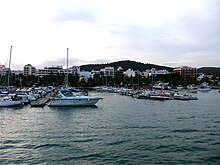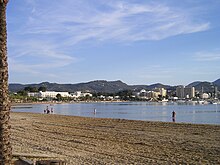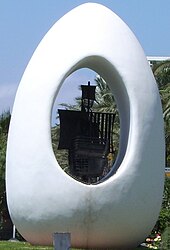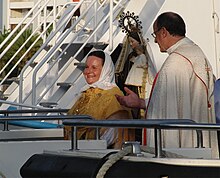Sant Antoni de Portmany
| Sant Antoni de Portmany
San Antonio Abad |
||
|---|---|---|
| coat of arms | Map of Spain | |

|
|
|
| Basic data | ||
| Autonomous Community : | Balearic Islands | |
| Island: | Ibiza | |
| Comarca : | Ibiza | |
| Coordinates | 38 ° 59 ′ N , 1 ° 18 ′ E | |
| Height : | 31 msnm | |
| Area : | 126.80 km² | |
| Residents : | 26,306 (Jan. 1, 2019) | |
| Population density : | 207.46 inhabitants / km² | |
| Postal code : | 07820 | |
| Municipality number ( INE ): | 07046 | |
| Nearest airport : | Ibiza Airport , 14 km | |
| administration | ||
| Official language : | Catalan , Spanish | |
| Mayor : | José Tur Torres (PSOE) | |
| Website : | www.santantoni.net | |
| Location of the city | ||
Ibiza and Formentera :
|
||

Sant Antoni de Portmany ( Spanish: San Antonio Abad ) is the largest city on the west coast of the Spanish island of Ibiza .
The large bay Bahía de Sant Antoni was already used by the Romans as a natural harbor and was called Portus Magnus . The bay is now home to the island's second largest port.
For 2000 years, Sant Antoni was nothing more than a small fishing village . It was not until the 1950s that the building of the well-known hotel castles began with increasing tourism , which still characterize Sant Antoni's cityscape today.
In the 1980s, Sant Antoni got the stigma of a holiday destination of British football - hooliganism , among which tourism had to suffer greatly. In the mid-1990s, the island was discovered by the clubber scene. Well-known locations are the Café del Mar and the Eden, one of the many big night clubs on Ibiza.
Surname
The Spanish and formerly official name for the city is San Antonio Abad . This is the Spanish name of the Christian Egyptian monk Anthony the Great . As part of the implementation of the Act on language normalization of the Balearic Islands took place in 1986 renamed the Catalan name Sant Antoni de Portmany . The word Portmany comes from the Latin term Portus Magnus (large port).
Administrative division
The municipality of Sant Antoni de Portmany is divided into five districts:
| Districts | Residents 2008 |
closed towns with population (2008) |
Residents outside of closed localities (2008) |
|---|---|---|---|
| Sant Antoni de Portmany (Spanish: San Antonio Abad ) |
17,587 | Sant Antoni de Portmany 16.131 |
1,456 |
| Sant Rafel (Spanish: San Rafael ) | 1,978 | Sant rafel 383 | 1,664 |
| Buscastell | 650 | - | 650 |
| Santa Agnès de Corona (Spanish Santa Inés ) | 422 | Santa Agnes de Corona 7 | 415 |
| Sant Mateu d'Albarca (Spanish: San Mateo ) | 376 | Sant Mateu d'Albarca 12 | 364 |
| local community | 21,082 | 16,533 | 4,549 |
population
Residents
The municipality of Sant Antoni has 26,306 inhabitants (as of January 1, 2019).
The population growth has been quite high since the beginning of mass tourism in the 1960s . While this was initially due to the influx of workers from mainland Spain, the number of inhabitants has increased since the 1990s, mainly due to the strong immigration of foreigners. As a result, the proportion of locals has continued to decline over the past few decades. Today less than half of the population (44.0%) are native of the Balearic Islands and only 19.1% are from Sant Antoni.
A resident of Sant Antoni is called in Catalan santantonienc (Spanish: sanantoniés ), a resident is santantonienca ( sanantoniesa ).
Development of the population:

Nationalities
| origin | according to citizenship (2008) |
according to country of birth (2008) |
|---|---|---|
| EU citizens | 86.9% | 84.7% |
| Spaniards | 76.0% | 73.9% |
| British | 2.9% | 3.2% |
| German | 1.9% | 1.9% |
| Romanians | 1.8% | 1.8% |
| Italian | 1.4% | 0.8% |
| French people | 1.0% | 1.0% |
| other Europeans | 0.4% | 0.5% |
| North and South Americans | 6.3% | 8.1% |
| Colombians | 1.3% | 1.4% |
| Uruguayan | 1.0% | 1.4% |
| Argentinians | 1.0% | 1.8% |
| Ecuadorians | 0.9% | 0.9% |
| Brazilian | 0.5% | 0.6% |
| Chileans | 0.5% | 0.5% |
| African | 5.5% | 5.4% |
| Moroccan | 5.2% | 4.9% |
| Asians | 0.8% | 1.3% |
The proportion of foreigners, at 24.0% (2008, only main residence), is about the island average, but is very high by Spanish standards. In 1991 there were far fewer foreigners living in Sant Antoni (4.2%). The number of foreigners has increased ninefold since then. The proportion of people born abroad is 26.1%.
Development of the proportion of foreigners:
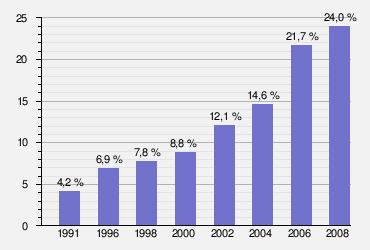
More demographic data
- In contrast to the Spanish average, the inhabitants of Sant Antoni are predominantly male (share: 52.5%, Spain: 49.5%, 2008). The decisive factor here is the high proportion of men among Latin American and, above all, Moroccan guest workers.
- With an average age of 37.1 years, the population is slightly younger than the Spanish average (39.5 years, 2001).
- There are 5,122 households; H. An average of 2.9 people live in a household.
- There are 8,990 apartments, of which 25% are second homes and 12% are vacant. The average year of construction of apartments is 1969.
- There are 3,988 buildings, 70% of which are single-family houses , 10% two-family houses, 10% houses with 3 to 9 apartments, 3% with 10 or more apartments and 7% non-residential buildings.
languages
Officially, Catalan and Spanish are equally official languages. On the public side, however, as in most other municipalities in the Balearic Islands, the Catalan language is preferred as llengua pròpia (native language), as there is no obligation to produce signs, documents, etc. in two languages. It is estimated that around half of the population speaks Catalan and one third speaks Spanish as their mother tongue , with Catalan speakers generally speaking Spanish as well as their mother tongue.
economy
The unemployment rate is 27.8% (2001; foreigners: 33.7%). 39% of the population are gainfully employed.
Landmarks and sights
Egg of Columbus
The Egg of Columbus (Catalan Ou de Colom ) is the most famous and also most striking landmark of Sant Antoni. It stands on a traffic island near the harbor promenade.
The egg was erected in honor of Christopher Columbus in the early 1990s . According to a local legend, Columbus is said to have been born in Ibiza (the same is said of the Phoenician general Hannibal in Ibiza ). In the hole in the middle of the ice is a replica of the Santa Maria , Columbus' flagship on his voyage to the West Indies . The shape of the statue goes back to the story of the egg of Columbus .
Passeig de ses fonts
Part of the promenade of Sant Antoni, the Passeig de ses Fonts, was built in 1990 to visually enhance the cityscape. There are many plants, such as palm trees and rubber plants, as well as massive fountains that are lit up at night. There are a number of restaurants and cafes above the square, with a view over the bay of Sant Antoni. The old town hall and post office are also located here.
West end
The “West End” is an area in Sant Antoni. It only spreads over a couple of streets. The main street is St. Agnés Street. The neighborhood has a range of bars ranging from dance to house music. Ibiza is famous for its rock and indie music. The name West End goes back to a minibus from the 1970s that brought visitors from Es Cana to Sant Antoni. The whole thing was called "The West End Experience".
Sunset Strip
Along the coast in the west is the famous Sunset Strip, where you can find various bars like Café del Mar and Café Mambo, where DJs like Swedish House Mafia, Carl Cox, David Guetta or Pete Tong perform regularly. Since the boulevard is to the west, sunsets can be seen regularly.
Ferries and boat crossings
There are various boats and ferries at the port of San Antonio that offer numerous connections to the beaches of Cala Bassa, Cala Compte, Pinet Playa, Es Puet, Cala Grasió, Cala Salada and Port es Torrent. The ferries leave daily until the end of September. A ferry to Formentera is possible once a week.
additional
- Cova de Santa Inés , cave chapel
Festivals
January 6th: Día de los Reyes Magos = Holy Three Kings . Parade of the kings who dock with a ship and ride through the town on horses and distribute sweets to the children.
July 16: Dia del Carmen = Stella Maris , patron saint of all sailors, fishermen and the Spanish Armada. With a procession from the church to the sea followed by a tour of the patron saints and the most important dignitaries of the place through the bay of Sant Antoni de Portmany.
August 24th: San Bartomeu = patronage festival with large fireworks
1st Saturday in September: Batalla de tomates entre Cartagineses y Romanos = Tomato battle between 'Romans' and 'Carthaginians' on the beach of Es Pouet .
Personalities
- Marcos García Barreno (* 1987), Spanish football player with Recreativo Huelva
Web links
- Official site of the city (Catalan and Spanish)
Individual evidence
- ↑ Cifras oficiales de población resultantes de la revisión del Padrón municipal a 1 de enero . Population statistics from the Instituto Nacional de Estadística (population update).
- ^ Instituto Nacional de Estadística: List of place names
- ^ Instituto Nacional de Estadística: Alterations to the municipalities in the Population Censuses since 1842
- ^ Instituto Nacional de Estadística: Population by sex, municipalities and nationality
- ^ Instituto Nacional de Estadística: Population by sex, municipalities and place of birth
- ^ Instituto Nacional de Estadística: Population and housing censuses 2001
- ↑ Official website for tourism in Ibiza: Sant Antoni De Portmany.Retrieved on August 29, 2014.


